Corelle “Forever Yours” dish: 15,300 ppm Lead + 269 Cadmium + 1,678 Arsenic. It’s your choice to eat off these – or not!
Introduction: Tamara Rubin is an independent advocate for consumer goods safety, and she is also a mother of Lead-poisoned children. She began testing consumer goods for toxicants in 2009 and was the parent-advocate responsible for finding Lead in the popular fidget spinner toys in 2017. She uses high-precision XRF testing (a scientific method used by the Consumer Product Safety Commission) to test consumer goods for metallic contaminants – including Lead, Cadmium, Mercury, and Arsenic.
XRF focus on pink hearts:
- Lead (Pb): 15,300 +/- 700 ppm
- Cadmium (Cd): 269 +/- 56 ppm
- Arsenic (As): 1,678 +/- 281 ppm
- Barium (Ba): 1,566 +/- 422 ppm
- Zinc (Zn): 623 +/- 84 ppm
- Nickel (Ni): 95 +/- 57 ppm
- Vanadium (V): 1,442 +/- 951 ppm
- Titanium (Ti): 16,300 +/- 700 ppm
- Chlorine (Cl): 8,927 +/- 1,270 ppm
XRF focus on tulip (pink and green):
- Lead (Pb): 5,159 +/- 192 ppm
- Arsenic (As): 691 +/- 110 ppm
- Barium (Ba): 1,479 +/- 332 ppm
- Chromium (Cr): 206 +/- 37 ppm
- Zinc (Zn): 267 +/- 44 ppm
- Nickel (Ni): 145 +/- 41 ppm
- Iron (Fe): 244 +/- 93 ppm
- Titanium (Ti): 7,204 +/- 295 ppm
- Chlorine (Cl): 5,570 +/- 940 ppm
Are the results reported above accurate?
Test results reported here on my blog are science-based, accurate, and replicable. Test results reported here are from tests that were done for a minimum of 60 seconds each (unless otherwise noted), and repeated multiple times, to confirm the results. As with all the testing reported here on my blog, a freshly-calibrated high-precision XRF instrument testing in Consumer Goods mode was used to test the item pictured here.
How much Lead is too much Lead?
There is no total content limit for total measurable Lead (as detectable and measured with an XRF instrument) in modern dishware. Limits have only been set for the total amount of any detectable Lead that is leaching at the time of manufacture – as measured by leach-testing. However, for context, for modern items intended for use by children to be legal (and not subject to recall) the paint or coating of these items needs to be below 90 ppm Lead, and the substrate of the item needs to fall below 100 ppm Lead when tested. If this dish were made today and “intended to be used by children”, it would be illegal. I consider dishes and kitchenware that test positive for Lead at levels below 90 ppm to be “Lead-safe”. [Note: my personal preference is to have all of the items in my own kitchen be 100% Lead-free – not just “Lead-safe”.]
Are you new here?
For those new to my website, please check out the menu in the header of the website for more information about how I test things (and my background, etc.) On each post you can also click on any of the keyword tabs at the top of the post to find more items in that category. Here’s the post discussing the type of testing I do, and the specific instrument I use to detect, analyze and confirm metals content, and ultimately produce the resultant data for each item reported here – link.
As always, thank you for reading and for sharing my posts. Please let me know if you have any questions!
Tamara Rubin
#LeadSafeMama
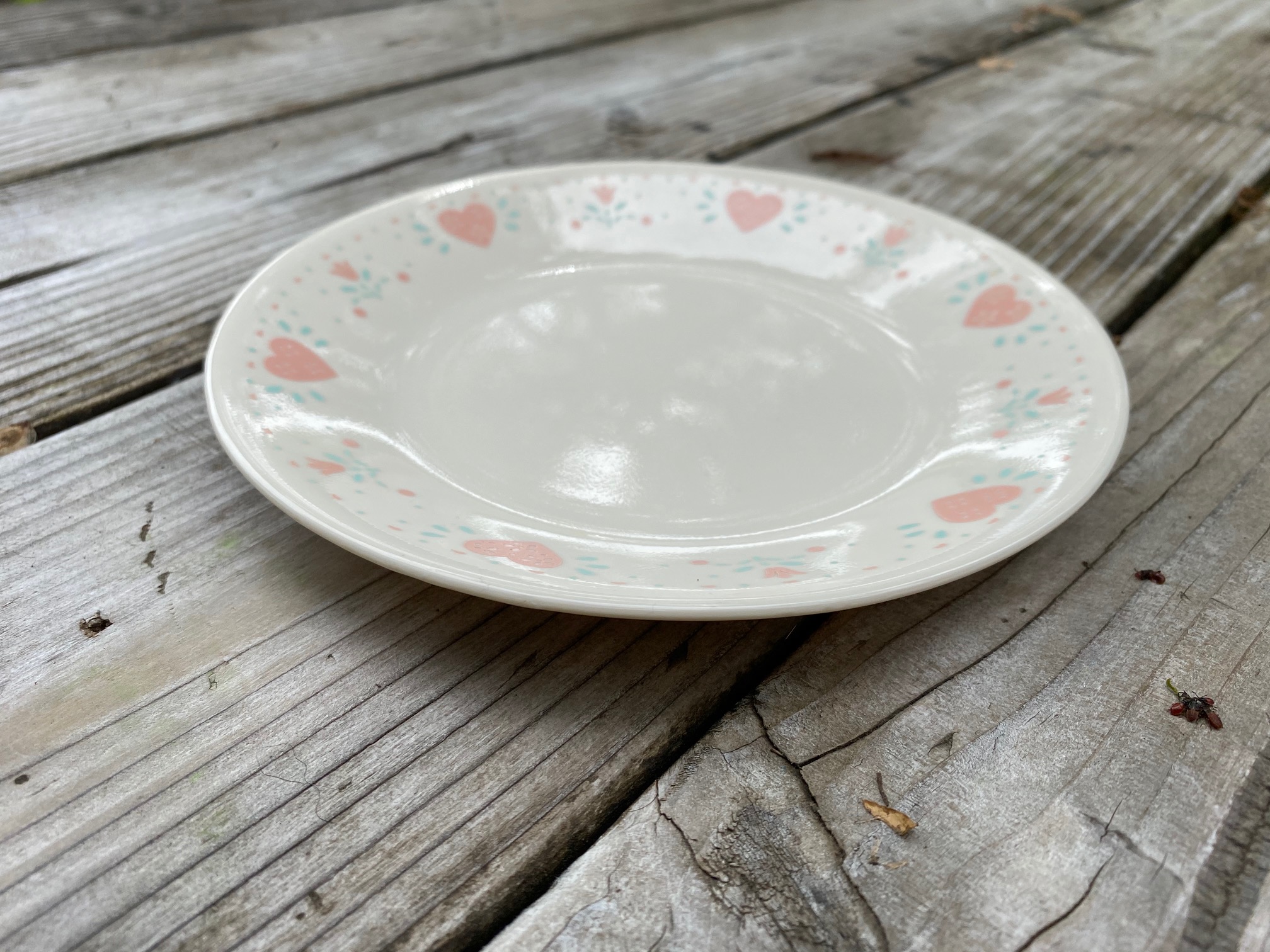
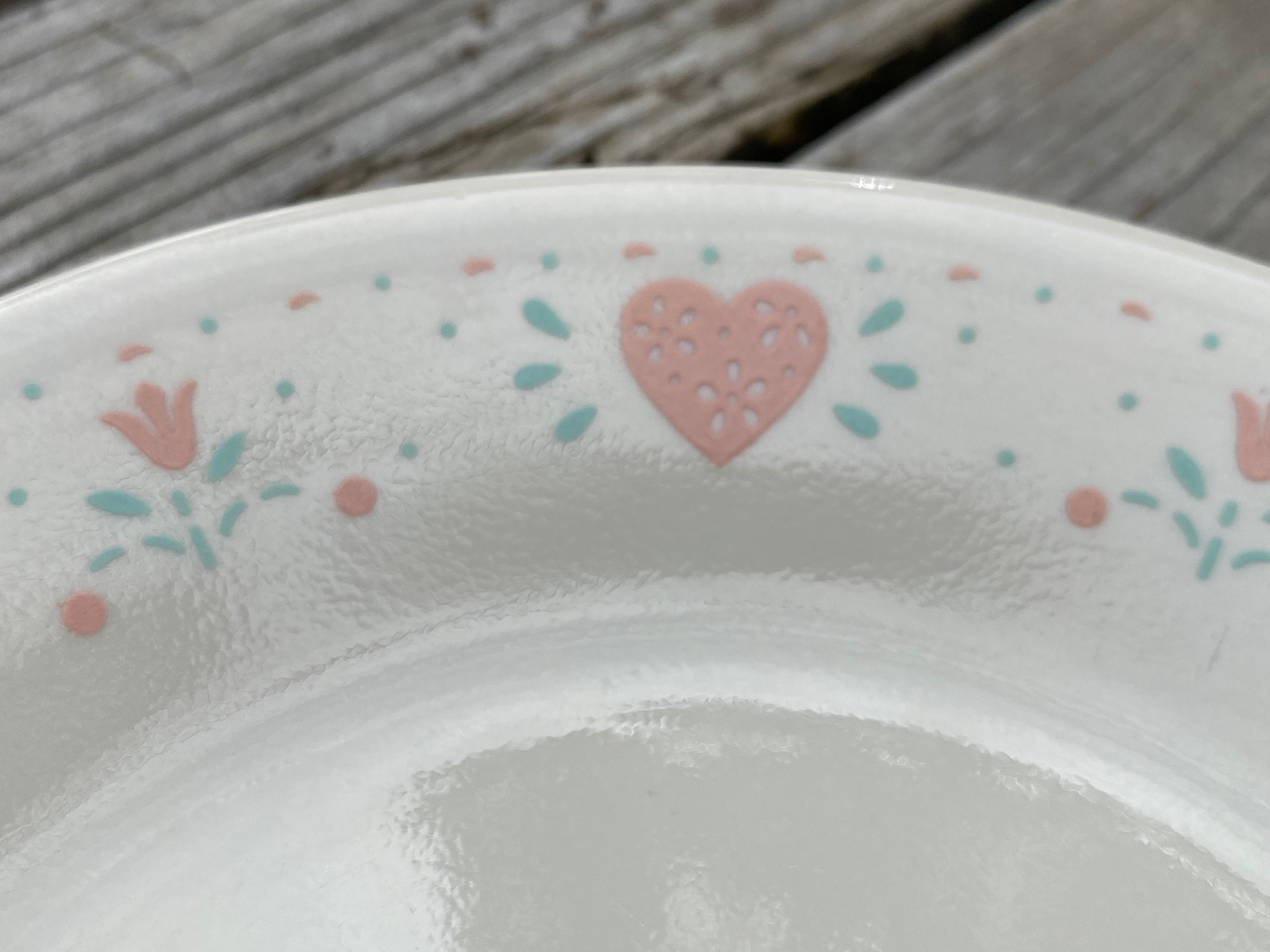
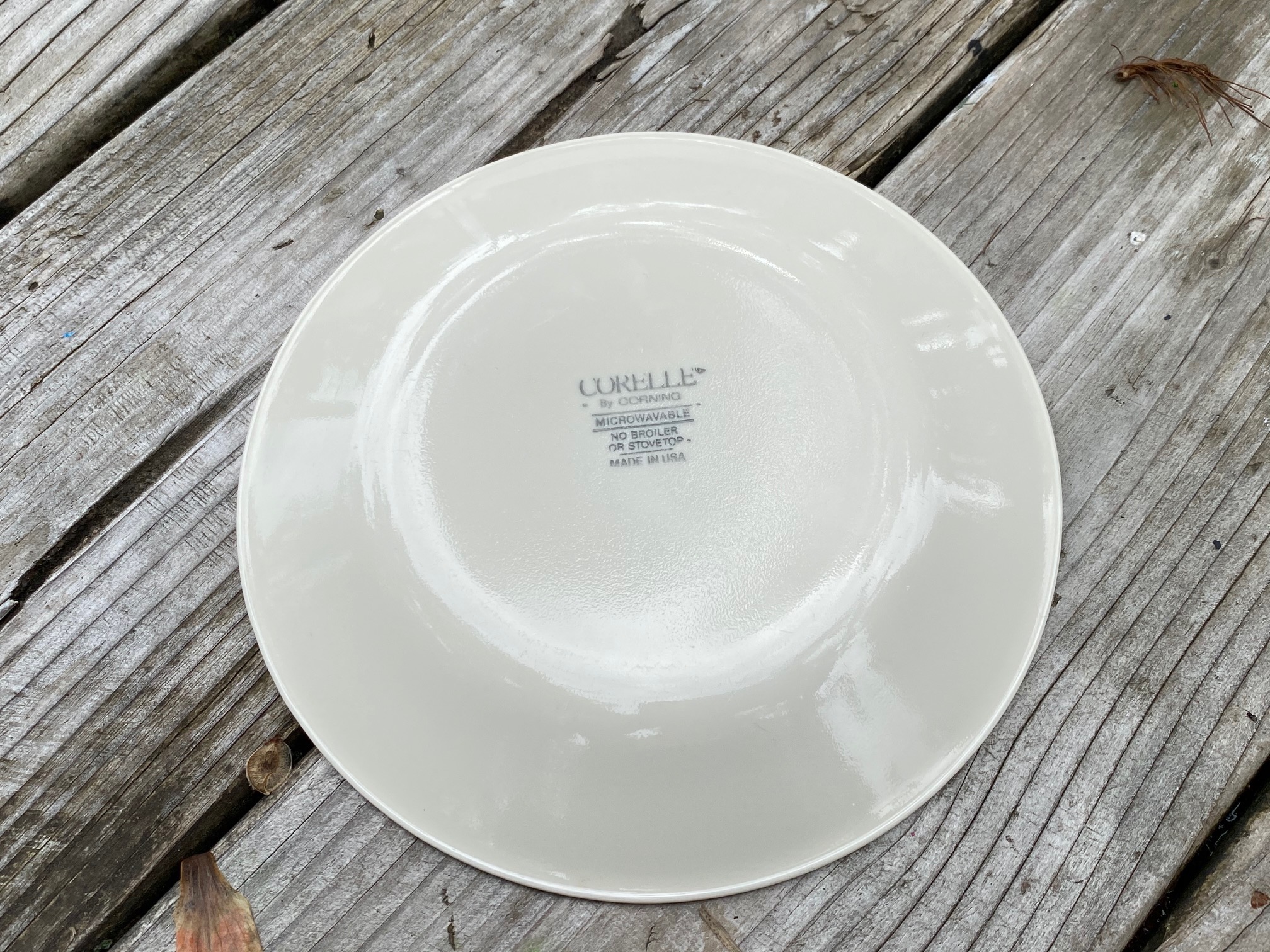
Never Miss an Important Article Again!
Join our Email List



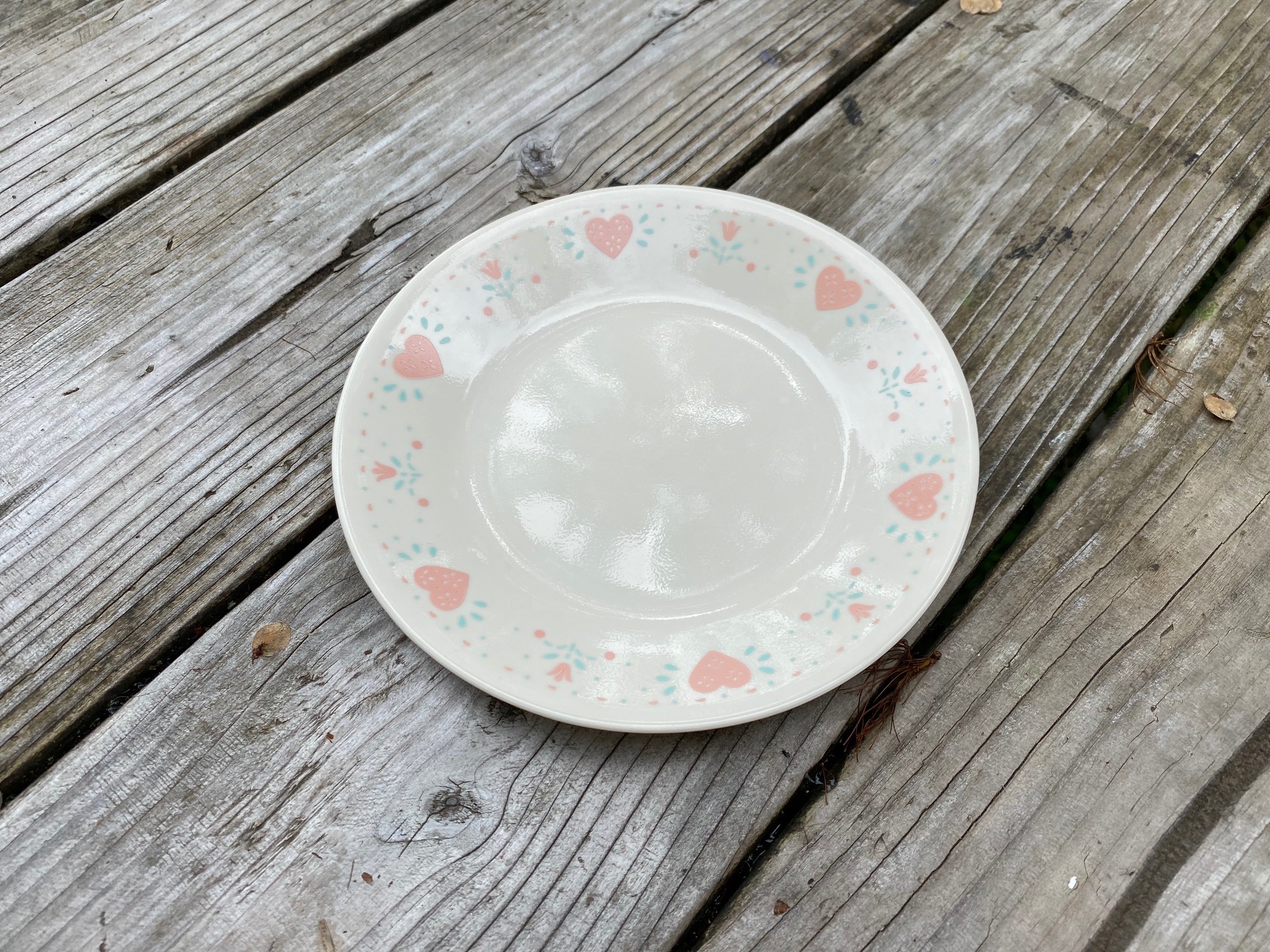
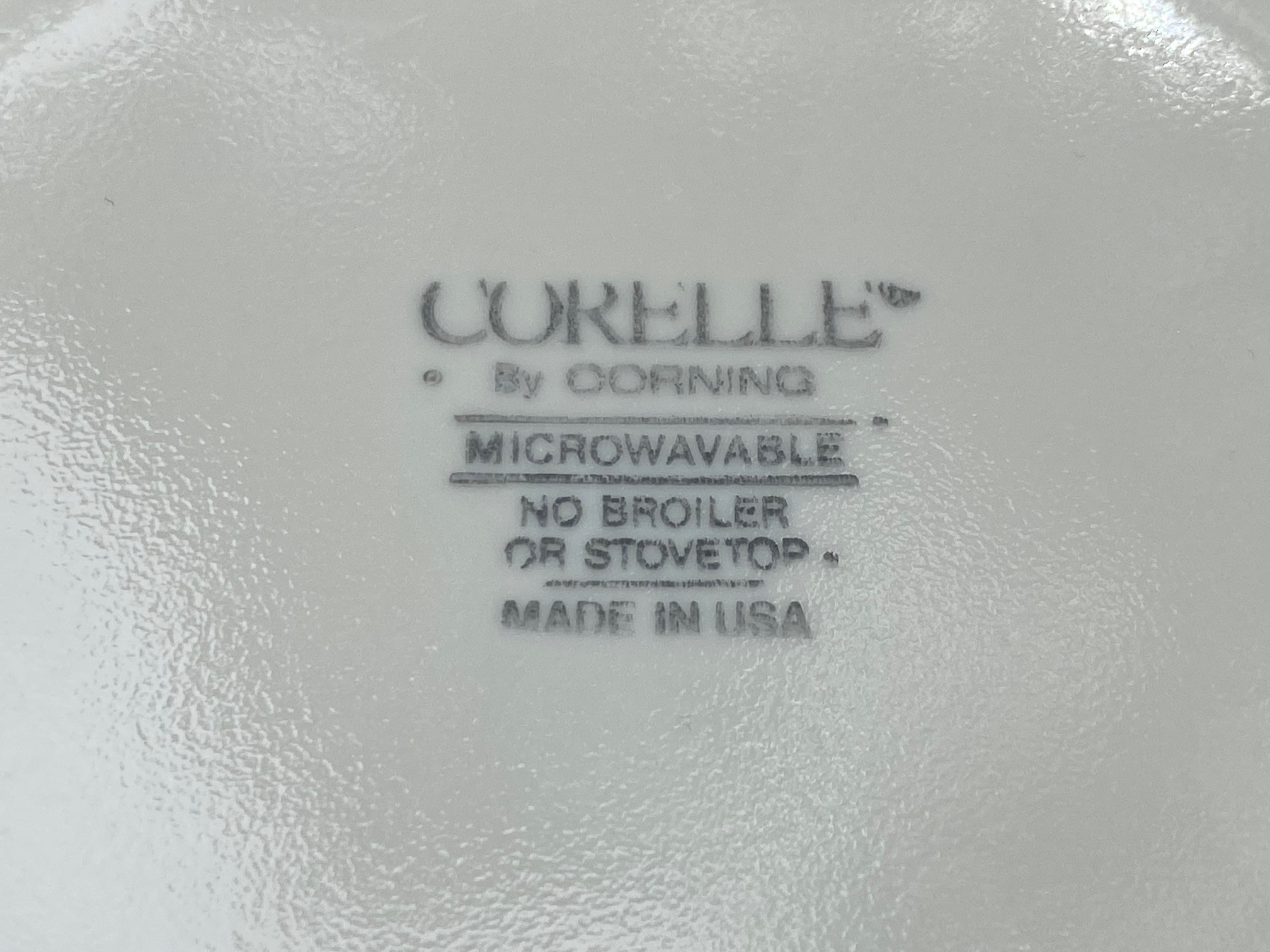

I recognize that this is vintage, and therefore the results are not surprising. The pink heart above seems to be rather a pastel color, yet has an alarming amount of lead content. I always try to figure out the “why” behind the use of lead, and one of the reasons usually provided is that it assists in producing bright colors and/or an iridescent quality in the finished product. This doesn’t seem to be the case here. I have also read that adding lead to paint makes it dry quicker, which to me is counterintuitive, but I do understand that, if true, it would be an economic incentive to using it in manufacturing processes. I’m curious about other potential reasons, maybe simply tradition? “That is the way we have always done it….” The amount of lead seems too much to be simply a contaminant, I would think… So, if it were intentional, what do you think would be the reasoning?
Hi Julia!
In this case I think paint on glass is often leaded to make it stick to glass substrates better, just as metal items (even modern metal items) are also often painted with Lead paint. Other similar examples are the painted markings on baby bottles (found in recent years), painted markings on fairly recent Pyrex measuring cups and painted markings on the glass carafe inside many French press coffee makers.
Thanks for commenting! I hope you are staying safe and healthy during these complicated times.
Tamara
If it is that dangerous, why doesn’t the company replace them with good ones?
I agree – I think they should.
Unfortunately companies are not taking responsibility for the toxic heavy metals found in their legacy products.
This is especially concerning when the legacy products are still in use in homes today – decades after they were manufactured (and therefore, given their age and history of use are more likely to deteriorate and cause health impacts!)
Tamara
I would hope that Corelle is intent on replacing our dishes, they weren’t cheap!
I have used Forever Yours pattern for decades ! ! !
I think the damage has already been done if we’ve been using these for years & years!!
I not only bought service for 12, I bought 12 matching coffee mugs, 12 drinking glasses, a cutting board, & teapot.
I am not happy Corelle’s answer is “use them for decorative pieces”. Who buys Corelle for decor? It isn like Corelle can compare to fine bone China and be displayed,
I bought these for everyday use. I fed my children and grandchildren off of this set.
My spouse is deceased from pancreatic cancer. I am in the diagnosis phase for cancer, with biopsy coming soon.
Gee, thanks Corelle for caring about your customers.
Thank you for sharing your story!
T
So should we get rid of these? And should out whole family be lead tested? Why is this NOT on CDC website or why isn’t there a national campaign about this! I am a NURSE and this is alarming and I am very upset. Corelle needs to take care of this and reimburse or replace or offer a hefty discount for ones without the chemicals. I am completely flabbergasted that there in no news coverage or statements being made to the public. This is a Community Health issue!
Hi Angela,
Personally I would not choose to use these for food use purposes (given Lead causes neurological issues and Cadmium causes cancer…. plus the level of Arsenic is quite upsetting as well.) There has been no testing done by Corelle (to date) to prove that their vintage dishware is safe / to prove that it does not leach toxicants from the painted decorative markings on the food surface – so in the absence of any testing determining these vintage dishes are safe, in my opinion this is a #KnowBetterDoBetter situation and these dishes should be destroyed so no one uses them for food in the future.
While I don’t have the means or the funding to conduct leach testing on vintage dishware, we have also done some informal preliminary testing demonstrating that the heavy metals do release from the decorative markings on these dishes over time / with use – so in my opinion they are likely not safe to use for food use purposes given the level of Lead (and other heavy metals) is so high (especially compared to the current allowable federal limits for Lead in items intended for use by children.)
There is a slim chance that Corelle may implement some sort of swap program (they have recently indicated in communications with Lead Safe Mama readers they may be doing some investigating into this issue and perhaps they will choose to do the right thing – if only for PR purposes) so you could set them aside in a box in the garage and keep an eye on this website and the news to see if they issue any additional public statement in the coming year (and do a product swap or refund.) I expect the chances of that are slim however.
The lead lobby is a very powerful lobby and they have their hands in a lot of pies politically and that is one reason there is not national outrage about this. I have not even been able to get the CPSC to issue a formal recall on recently sold lead painted baby bottles – you can read more about that here: https://tamararubin.com/2022/05/simplified-summary-of-lead-safe-mama-findings-for-lead-painted-baby-bottles-purchased-on-amazon-in-2021/
This is why the word-of-mouth on this issue is so important – since the news seems reluctant to pick it up.
In my opinion it is worthwhile for the whole family to be tested – if only to have a baseline for Lead so you know if there is something to be concerned about now or in the future. Given dishware creates chronic low level exposure (in most cases) a urine or hair test might be more informative than a blood test.
Here’s my article about urine testing (which is controversial):
https://tamararubin.com/2020/05/i-heard-that-urine-and-hair-tests-for-heavy-metals-including-lead-were-not-real-or-useful-test-results-why-is-this/
Here is my article about blood lead testing:
https://tamararubin.com/2019/02/blood-lead-testing-please-get-everyone-in-the-family-tested-since-you-have-been-living-in-a-house-with-high-lead-paint/
Since you are a nurse I want to share a private preview screener link to my documentary film with you. I have done presentations sponsored by / hosted by State health departments where Nurses get CEUs to come watch the film and participate in a post-screening discussion that I host with other experts on the subject. The film also covers (to some degree) the political corruption behind the issue:
Thank you for taking the time to comment!
Tamara
How do I know then what is safe and what is not.
I have the set, Forever Yours. So what do I do with a set of 12? I won’t give them away! Also, any daft on Corelle’s Farm Fresh?
Thank you!
Here’s the overview post about Corelle (I don’t have them all listed by name so it might be better to look for them via descriptors):
https://tamararubin.com/2019/12/breaking-news-12-26-19-corelle-recommends-using-their-pre-2005-dishes-only-as-decorative-pieces-due-to-concerns-for-high-levels-of-lead/
Here’s the post about efficiently searching the blog:
https://tamararubin.com/2020/12/how-to-use-the-lead-safe-mama-website-video/
Here’s my post about disposal:
https://tamararubin.com/2019/12/what-should-i-do-with-my-lead-contaminated-dishes-to-toss-or-not-to-toss/
Here’s how to send in a piece for testing:
https://tamararubin.com/2019/08/tamara-can-i-send-you-one-of-my-dishes-to-test-for-lead/
I have a set of 12 in each of these patterns! If they are not flaking off, are we still exposed to lead?? I don’t understand why this has just become an issue. I’ve had mine for a long time!!
Hi Janet –
The amount of Lead that can poison humans is literally invisible to the naked eye. If you notice “flaking off” it is too late. The paint / coating wears over time – and this is not always noticeable. It is too costly for folks to do leach testing on every set of dishes (to find out if your particular set is leaching lead would cost more than replacing with lead free alternatives) so removing the leaded items from use in your home is the safest path. A new set of lead free dishes can cost just about $1 or $2 per dish, and in my opinion the risk is not worth it (to hold on to high lead dishes), when the cost to fix the problem is so nominal.
Here’s a post with many types of Lead-free dishes, but you can also check out Target, Walmart and Ikea for similar safer (less expensive) non-toxic options:
https://shopleadsafemama.com/2021/05/lead-free-dishes/
Leaded paint on dishes has been an issue since there have been dishes – but regulatory standards protecting children and setting strict safety limits for Lead only went into effect in 2008. Even then, dishes are not considered to be “items intended for use by children” and are still manufactured today with unsafe levels of Lead. Here’s a good example of a high-Lead pattern sold this year (2022) at WILLIAMS SONOMA:
https://tamararubin.com/2022/02/new-2022-williams-sonoma-sicily-pattern-dish-made-in-italy-15800-ppm-lead-20000-ppm-cobalt-243-ppm-antimony-381-ppm-cadmium/
Here also is my exchange with that company:
https://tamararubin.com/2022/02/communications-from-williams-sonoma-public-relations-team-in-response-to-my-recent-findings-of-lead-and-other-toxicants-in-their-new-2022-dishes/
Tamara
Hello Tamara, I wish I found you before. i have the Forever yours Corningware 3 liter with Crock-Pot, I assume has the same amount of lead and the cadmium, no wonder we have serious health problems, to count some, lost of memory, lock of concentration, poor performance. I love Corningware products but hate knowing bhow they poison usbon purpose, they knew we will be eating out of them and serving our children on those dishes. Shame on them.
Thank you for commenting. I do wish they would take a better (proactive) stand about their vintage pieces. We did get this one response but it was not from top of corporate or anything like that:
https://tamararubin.com/2019/12/breaking-news-12-26-19-corelle-recommends-using-their-pre-2005-dishes-only-as-decorative-pieces-due-to-concerns-for-high-levels-of-lead/
Tamara
I am not only concerned with the pattern….. but the overall colour and glaze. Has the middle of a dish in question been tested?
Hi Tamara,
Thank you for all the work that you do! I wanted to ask if there is any correspondence from Corelle with the “2005” year listed. What I have seen is language using the term “mid 2000’s” which, of course, could be interpreted to mean specifically 2005, but since it is rather vague language, could mean a range of dates. Since it is difficult to determine dates anyway without markings on the plates, maybe my question is rather moot, but I’m curious if the company itself ever mentioned the 2005 date… Perhaps I missed something….
Thanks!
Only this. Mid-2000s (Which is also consistent with testing I have done for Lead – although more recent dishes can have unsafe levels of Cadmium instead) https://tamararubin.com/2019/12/breaking-news-12-26-19-corelle-recommends-using-their-pre-2005-dishes-only-as-decorative-pieces-due-to-concerns-for-high-levels-of-lead/
Would this also include the matching glasses? Or just the plates?
Same question
I would assume same design, same paint. They didn’t care enough for their customers safety and well being on the dinnerware….. I can’t see them buying a different paint for the drinking glasses, coffee mugs, casserole dishes, cutting board, teapots, etc.
I have almost every item that was offered in this pattern.
What about Corning ware baking dishes with the clear glass lid? They were not mentioned in the listing.
Same question
is it just the painted part that contains the lead, cadmium, and arsenic or the make-up of the dishware itself?
I have the same question. I will seriously consider getting rid of any pieces that food touches the painted part, but my CorningWare casserole dishes are only painted on the outside surface. If the danger is only in the paint, I see no reason to stop using them.
Hi Leah,
Thank you for commenting! Please read this article for context:
https://tamararubin.com/2020/07/if-the-lead-is-only-on-the-outside-of-my-dish-measuring-cup-mixing-bowl-etc-why-does-it-matter-that-it-has-lead/
Thank you!
Tamara
We just discovered that our Forever Yours set which originally consisted of 12 dinner plates, 10 appetitzer plates, 12 dip bowls and 12 mugs, but was purchased with fewer items via Craigslist in 2013, has lead. Our 1 year old and 3 year old have been eating off of these plates every day. We immediately threw them away. We called Corelle and though they were defensive (said that they did tests that showed there was no leaching) I explained that obviously I wasn’t able to take any risks with my family. They then were willing to provide us with a 30% discount on replacement products. We got a slightly different assortment but were able to get replacements for $100, which is a good price.
Thank you for commenting about this here! It is so concerning that their statement (generally) is that these items contain a “small amount” of Lead. Yes 15,300 parts out of 1,000,000 parts is technically small (as far as numbers and fractions and percentages go) – but it is not at all small when it comes to measuring Lead on the food contact surface of dishes! Lead is poisonous at microscopic (literally invisible) amounts. I would love the opportunity to school Corelle’s P.R. people in person!
T